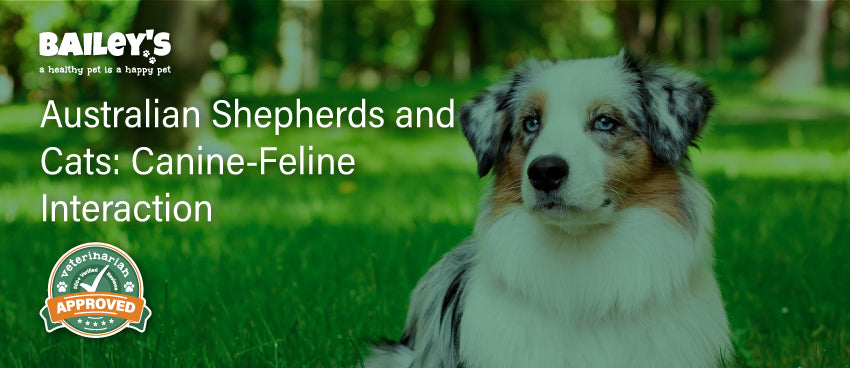Australian Shepherds and Cats: Canine-Feline Interaction

Dogs and cats have been long considered natural adversaries, but is this the case? In this article, we will explore the dynamics of canine-feline interaction, with a specific focus on Australian Shepherds and cats. With the help of our friends at Bailey’s CBD , we will delve into the breed characteristics and temperament of Australian Shepherds, as well as common traits and behavior patterns of domestic cats.

Furthermore, we will discuss factors that influence inter-species relationships and provide tips for fostering positive interactions. Lastly, we will address the common challenges that arise in dog-cat interactions and strategies for resolving conflicts. By the end, you will be equipped with a deep understanding of Australian Shepherds and cats, laying the groundwork for harmonious coexistence.
Table of Contents
- 1. Understanding the Nature of Australian Shepherds
- 1.1 Breed Characteristics of Australian Shepherds:
- 1.2 Temperament and Behavior of Australian Shepherds:
- 2. The Feline Factor: Getting to Know Cats
- 3. The Dynamics of Canine-Feline Interaction
- 4. Australian Shepherds and Cats: A Detailed Look
- 5. Troubleshooting Problems in Canine-Feline Relations
- 6. Conclusion
1. Understanding the Nature of Australian Shepherds
Australian Shepherds, often known as "Aussies," are highly intelligent and energetic dogs that were initially bred as herding dogs in the United States. They are medium-sized with a well-muscled body and a distinctive bobtail. The breed is known for its agility and versatility, excelling in various activities such as obedience, agility trials, and herding competitions.
Australian Shepherds have a fascinating history that dates back to the 19th century. Despite their name, they did not originate from Australia. Instead, they were developed in the western United States, where they were used to herd livestock, especially sheep. Their exceptional herding skills and unwavering dedication made them indispensable to ranchers and farmers.
1.1 Breed Characteristics of Australian Shepherds:
- Size: Australian Shepherds are medium-sized dogs, with males typically ranging from 20 to 23 inches and females from 18 to 21 inches in height.
- Coat: They have a thick double coat, with a straight to slightly wavy outer coat and a dense undercoat.
- Color: Aussies come in a variety of colors, including black, blue merle, red merle, and red, often with white and copper markings.
- Temperament: They are known for being highly intelligent, loyal, and trainable. Aussies thrive on mental and physical stimulation, and they require an active lifestyle to prevent boredom and destructive behavior.
Australian Shepherds are often admired for their physical attributes and also for their exceptional intelligence. They are often ranked among the smartest dog breeds, capable of learning and performing complex tasks. Their intelligence, combined with their eagerness to please, makes them highly trainable and suitable for various roles, including search and rescue, therapy work, and even competitive dog sports.
1.2 Temperament and Behavior of Australian Shepherds:
Australian Shepherds are generally friendly and gentle but can be reserved with strangers. They tend to be loyal and protective of their families, making them excellent watchdogs. Aussies have a strong herding instinct, which may manifest in behaviors such as chasing and nipping, especially in the absence of proper training and socialization.
It is important to note that Australian Shepherds require consistent training and socialization from an early age to ensure they grow up to be well-rounded and well-behaved dogs. Early exposure to various people, animals, and environments can help them develop into confident and adaptable companions.
Due to their high energy levels, Australian Shepherds thrive in active households where they can receive plenty of exercise and mental stimulation. Daily walks, playtime, and interactive toys are essential to keep them physically and mentally engaged. Without adequate exercise and mental stimulation, Aussies may become bored and resort to destructive behaviors such as excessive barking or chewing.
Australian Shepherds are remarkable dogs with a rich history and a unique set of characteristics. Their intelligence, agility, and loyalty make them a popular choice for dog enthusiasts who are looking for an active and versatile companion. With the right training, socialization, and care, Aussies can thrive in various environments and bring joy and companionship to their families.
2. The Feline Factor: Getting to Know Cats
Cats, which have been domesticated for thousands of years, exhibit a wide range of temperaments and behavior patterns. Understanding their nature is vital for creating a harmonious environment with canine companions, such as Australian Shepherds.
2.1 Common Traits of Domestic Cats:
- Independence: Cats are known for their independent nature. They enjoy having a sense of control over their environment and prefer to be treated with respect and gentleness.
- Cleanliness: Cats are meticulous groomers and can spend about half of their waking hours on self-grooming.
- Territoriality: Cats are highly territorial animals. They establish and defend their territory by marking it with scent and visual cues.
2.2 Understanding Cat Behavior:
Cats communicate mainly through body language, including tail position, ear position, and vocalizations. Each cat has a unique personality, and their behavior can be influenced by various factors such as socialization, experiences, and individual preferences.
When it comes to independence, cats have a reputation for being self-reliant creatures. They are known to have a strong sense of autonomy and prefer to have control over their environment. Unlike dogs, who often seek constant attention and affection, cats are content with their own company. This independent nature is deeply ingrained in their DNA, as their ancestors were solitary hunters in the wild. Cat owners need to understand and respect this need for independence, providing them with ample space and opportunities for solitude.
In addition to their independent nature, cats are also known for their impeccable cleanliness. They are meticulous groomers, spending a significant amount of time each day on self-grooming. Cats use their tongues to clean their fur, removing dirt, debris, and loose hair. This grooming behavior not only keeps them clean but also helps distribute natural oils throughout their coat, keeping them healthy and shiny. It is fascinating to observe how cats meticulously groom themselves, often contorting their bodies into various positions to reach every nook and cranny.
Territoriality is another prominent trait in domestic cats. They have a strong instinct to establish and defend their territory. Cats mark their territory using scent and visual cues. They have scent glands on various parts of their body, such as their face, paws, and tail, which they use to leave their unique scent on objects and surfaces in their environment. This scent marking serves as a way for cats to communicate with other cats, signaling ownership and boundaries. Additionally, cats may also use visual cues, such as scratching furniture or vertical surfaces, to mark their territory and assert their presence.
Understanding cat behavior goes beyond recognizing their common traits. Each cat has a unique personality shaped by various factors. Socialization plays a crucial role in a cat's behavior, especially during their early development stages. Cats that have been exposed to positive experiences and interactions with humans and other animals tend to be more sociable and friendly. On the other hand, cats that have had limited socialization may exhibit more fear or aggression towards unfamiliar people or animals. Cat owners should provide proper socialization opportunities to ensure their cats grow up to be well-adjusted and confident individuals.
Experiences also play a significant role in shaping a cat's behavior. Traumatic experiences, such as abuse or neglect, can have long-lasting effects on a cat's behavior and may lead to fear, anxiety, or aggression. Conversely, positive experiences, such as being rewarded for good behavior or engaging in interactive play, can reinforce positive behaviors and strengthen the bond between a cat and their owner.
Individual preferences also influence a cat's behavior. Just like humans, cats have their likes and dislikes. Some cats may enjoy being petted and cuddled, while others may prefer to be left alone. Some cats may be more adventurous and curious, while others may be more cautious and reserved. Cat owners must seek to understand and respect their cat's individual preferences, providing them with an environment that caters to their specific needs and desires.
3. The Dynamics of Canine-Feline Interaction
The dynamics of canine-feline interaction are influenced by multiple factors, including the temperament of the particular dog and cat, their individual experiences, and the environment in which they coexist.
3.1 Factors Influencing Inter-Species Relationships:
- Early Introductions: Introducing a dog and a cat at a young age can increase the likelihood of them forming a positive bond.
- Positive Associations: Associating positive experiences such as treats and playtime with each other's presence can help foster a friendly relationship.
- Proper Socialization: Ensuring dogs and cats are exposed to a wide range of experiences and stimuli during their early development stages can help them become comfortable around each other.
3.2 Common Challenges in Dog-Cat Interactions:
- Prey Drive: Dogs, including Australian Shepherds, have a natural prey drive that may cause them to chase small animals, including cats. This behavior can potentially lead to conflicts if not properly managed.
- Territoriality: Cats are territorial animals and may perceive the presence of a dog as a threat to their territory, leading to defensive behaviors such as hissing or swatting.
4. Australian Shepherds and Cats: A Detailed Look
Now, let's specifically explore how Australian Shepherds typically react to cats and the necessary steps to promote positive interactions in their coexistence.
4.1 How Australian Shepherds Typically React to Cats:
Due to their herding background, some Australian Shepherds may have a strong prey drive towards cats. However, with proper training, socialization, and gradual introductions, many Australian Shepherds successfully coexist with cats.

4.2 Tips for Fostering Positive Interactions:
- Supervised Introductions: Start with short, supervised interactions between your Australian Shepherd and the cat. Gradually increase the duration and observe their behavior closely.
- Positive Reinforcement: Reward your dog and cat for calm behavior and positive interactions, using treats or verbal praise.
- Separate Spaces: Provide separate areas for your dog and cat, with their own food, water, and litter boxes. This allows them to have their own safe spaces and reduces potential conflicts.
5. Troubleshooting Problems in Canine-Feline Relations
Despite our best efforts, conflicts and challenges in dog-cat interactions can still arise. It is essential to address these issues promptly to ensure a harmonious coexistence.
5.1 Identifying Signs of Conflict:
Signs of conflict between an Australian Shepherd and a cat may include growling, hissing, swatting, raised fur, or a tense body posture. It is important to intervene early to prevent escalation of the situation.
5.2 Strategies for Resolving Issues:
- Professional Guidance: Seek advice from a professional dog trainer or animal behaviorist, who can provide guidance tailored to your specific situation.
- Gradual Reintroduction: If conflicts have occurred, it may be necessary to reintroduce your Australian Shepherd and cat slowly. Use positive reinforcement training techniques and ensure that both animals feel safe and comfortable.
- Environmental Enrichment: Provide mental and physical stimulation for both your dog and cat through interactive toys, puzzle feeders, and regular exercise. This can help redirect their energy and reduce potential conflicts.











